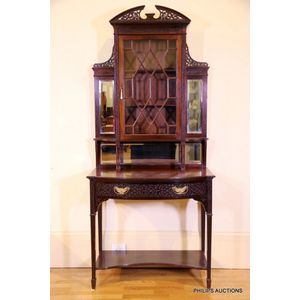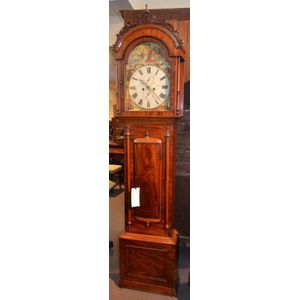Rosewood Marquetry Display Sideboard
A rosewood and marquetry inlaid display sideboard. 267 cm high, 153 cm wide, 47 cm deep.
You must be a subscriber, and be logged in to view price and dealer details.
Subscribe Now to view actual auction price for this item
When you subscribe, you have the option of setting the currency in which to display prices to $Au, $US, $NZ or Stg.
This item has been sold, and the description, image and price are for reference purposes only.
- Rosewood - A dense timber that varies in shade to very light brown to almost black. When rosewood is cut and sanded the colour of the timber will turn black, and after polishing and exposure to daylight, the surface will gradually lighten over time to light brown with black streaks.
The name comes from the odour emanating from the timber when it is planed, sanded or cut.
Rosewood was very popular for use in Victorian furniture in the second half of the 19th century, and at that time most of the rosewood was imported from Brazil. However it also grows in India and Indonesia.
It is used in the sold for chairs and table legs, but for carcase furniture such as side cabinets and bookcases, and for table tops it is always used as a veneer. - Marquetry - In marquetry inlay, contrasting woods, and other materials such as ivory, shell and metal are inlaid either as panels or in a single continuous sheet over the surface of the piece. The design may be straightforward, such as a shell pattern or a basket of flowers, or it may be infinitely complex, with swirling tendrils of leaves, flowers and foliage, such as one finds, for example, in the "seaweed" patterns on longcase clocks of the William and Mary and Queen Anne periods.
- Inlay - Decorative patterns inserted into the main body of a piece of furniture, generally in wood of contrasting colour and grain, though brass, ivory, ebony, shell and sometimes horn have been used. Inlay may consist of a panel of well figured timber inset into a cabinet door front, geometric patterns, or complex and stylized designs of flowers, swags of foliage, fruits and other motifs. As a general rule, in pieces where the carcase is constructed in the solid, the inlay is relatively simple such as stringing, cross banding and herringbone banding. Where more elaborate and decorative work was required veneer was used. Inlay has been fashionable from at least the latter half of the 17th century, when a variety of elaborate forms were developed
Visually similar items

French Henri II credenza, approx 180 cm high, 65 cm wide
Sold by
in
for
You can display prices in $Au, $US, $NZ or Stg.

A superb Edwardian sideboard of exhibition quality. Height 260 cm. Width 170 cm. Depth 55 cm
Sold by
in
for
You can display prices in $Au, $US, $NZ or Stg.

A Chippendale revival mahogany and mirrored cabinet on stand, early 20th century, with a broken arched pediment above a central astragal glazed cupboard flanked by mirrors and shelves, a shallow full width mirror and a bow front extended base with drawer r
Sold by
in
for
You can display prices in $Au, $US, $NZ or Stg.

A Scottish mahogany longcase clock
Sold by
in
for
You can display prices in $Au, $US, $NZ or Stg.
